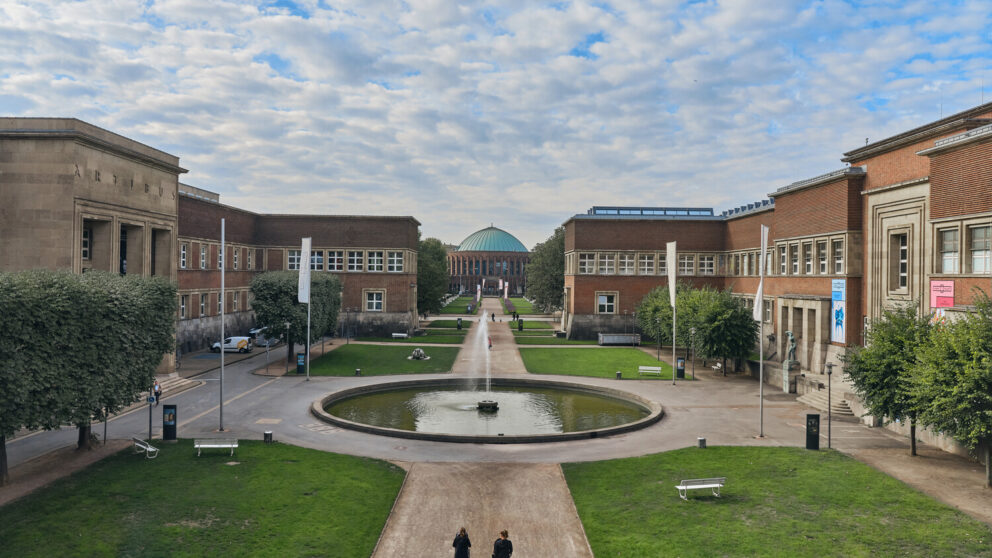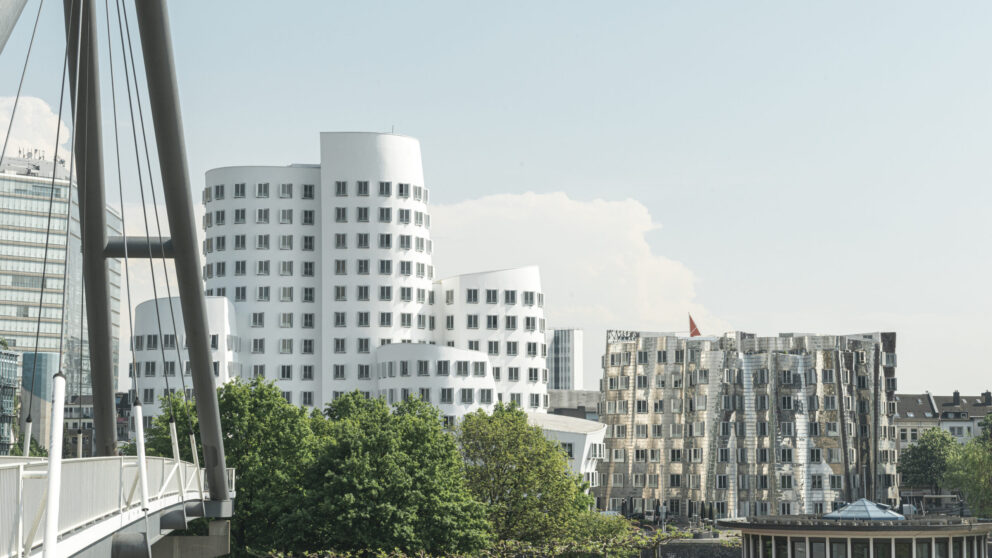
Six of the best in the Botanical Garden
Six highlights in the Botanical Garden: from a trip around the world to a real VIP
On eight hectares of land you will not only travel to almost all corners of the earth by means of flora - and sometimes also fauna - but also get to see the most rare guests.
The Botanical Garden, which was opened in 1979, is a very special green space in the south of Düsseldorf. Directly adjacent to the Heinrich Heine University, it is not only students, professors and the gardening team responsible for maintaining the grounds at Universitätsstraße 1 that cavort here all year round. More than 6,000 plant species also call this little spot in the Wersten district home - even though some of them come from the most remote corners of the planet. Dive into the world of botany on the approximately one-kilometer-long circular path, without which we could not exist, but which is increasingly coming under threat.
Despite trends like urban gardening and farming, and the recent hype about houseplants, unfortunately fewer and fewer of us understand how nature, and flora in particular, really works. Fortunately, the Botanic Garden - and experts like Larissa Sieben - are there to educate us. She has been working as a garden master on site for a decade and now trains future colleagues. In addition, the 44-year-old regularly guides interested visitors around the grounds (Sundays open to the public and free of charge at 3 p.m., Saturdays from 11 a.m. special tour for families with children; an audio guide is also available). She revealed her highlights to us.
A real celebrity, brought in from Down Under
He almost hides a little, perhaps the biggest celebrity the Botanical Garden has ever seen. Once inside the 1000 square meter domed greenhouse, it takes a few steps past the flora of the Canary Islands before he - or rather she! - emerges: Allow me to introduce you to a true Wollemie! "In 1994, a ranger discovered a row of the trees by chance in a gorge in Australia," says garden master Larissa Sieben, "although it had long been considered extinct!" In the meantime, many of them have been bred, and a magnificent specimen is now growing in Düsseldorf, and the Wollemie seems to have taken such a liking to its neighborhood of floral representatives from, among other places, New Zealand, Asia and other regions with warm summers and rainy winters that it literally blossomed in 2020. A sensation, as if Fortuna Düsseldorf won the Champions League! And so the tree, just quite VIP, found itself in all newspapers, magazines and web portals. There are even offspring, which the gardener responsible for the domed greenhouse plans to plant in the Botanical Garden. Until a Wollemien forest grows in Wersten, enjoy the sight of aloe vera, fig, eucalyptus and viper's bugloss, among others, whose flower stalks rise up to two meters in the air - and greet the equally huge tree fern that inhabited this earth even when dinosaurs were still running around.
Oh, and when you leave the domed greenhouse, don't miss the plant exchange at the entrance. Perennials and houseplants are waiting for a new home for a donation.
Around the world in 80 minutes
Jules Verne might have reconsidered his book title if the Botanical Garden had already existed in 1873. After all, who wants to travel around the world in 80 days when you can do it in 80 minutes? That's how fast you walk from lavender fields like those in France to North America's swamp zone to China's plant world. "At any time of year, but especially in winter, it's worth visiting this section," Larissa Sieben tells us. This is because the Chinese winter flower exudes a fragrance that is just as intense as it is "incredibly good-smelling" as the winter hedge cherry. After a few meters, you will pass the border to Japan with, among other things, particularly pretty shining foliage in autumn, before you reach the Caucasus - and thus one of Larissa Sieben's favorite places. "I especially love spring here! In addition to grape hyacinths and snowdrops, for example, several bushes of different types of peonies are blooming here!" Our favorite: the willow-leaved pear with shimmering silvery, narrow foliage. You're best off retreating to the European oak-hornbeam forest, just a few hundred yards away, in midsummer, when the trees provide extra shade thanks to their dense canopy. "And there's really nothing better at 30 degrees than evaporative cooling," expert Sieben knows.
Kitchen garden - and a pharmacy under the open sky
Would you have thought that apples can also suffer from calcium deficiency? Or that plants like woad can give your jeans their typical blue hue? And the amount of plants that are able to influence our body from blood to mental health! You can learn all this information - and infinitely more - in the kitchen garden. It is a focal point of the site, as many researchers operate here and study, for example, the effective growth of rice, corn and barley. In enclosed beds you will also discover various types of vegetables, energy and textile plants, and herbs. In the open-air pharmacy adjacent to the kitchen garden, in turn, around 100 pharmacologically relevant plants grow, from field horsetail to meadow yarrow, which - like all the plants in the facility - thrive free of pesticides and similar agents. The labels can even be scanned via smartphone using QR codes. "We are also pleased to have five new fruit trees, namely pears, apples and a mirabelle plum," adds Larissa Sieben. All varieties are on a special list of the Nature and Biodiversity Conservation Union (Nabu), as they are old species that are hardly still common. It's clear that the entire team at the Botanic Garden is eagerly awaiting the harvest!
A star on four paws
What would flora be without fauna? And so a multitude of animal inhabitants cavort on the eight-hectare site, which you can observe with a little luck at any time of the year and day. A special experience is certainly the discovery of the blue-orange feathered kingfishers, of which at least two live in the Botanical Garden. "It is possible that they are a pair, but we don't know for sure," Larissa Sieben tells us. One thing is certain: At the right time in the right place, namely the lake not far from the domed greenhouse, the birds can be caught snatching a fish. A rare but not impossible sight! The resident nutria, herons, squirrels, toads and rabbits prove to be somewhat less shy. Whereby nothing and nobody, neither on two nor on four feet or paws, can stand against Lucy! The black cat is the true star of the Botanical Garden. The stray animal, long known as "Campus Cat", is already followed by several hundred people on his own Instagram account, profile name "bogacathhu".
On the road in South Africa
Pure white flowering heather, so large that it would never fit into the flower boxes normally intended for it, stonecrops and yet another plant known far beyond Düsseldorf: "Welcome to the South Africa House" is the motto of the 330 square meters that give you a first impression of the local steppe vegetation. The special feature: Specimens grow here that botanists brought back from the country in the southern hemisphere half a century ago. Strictly forbidden today, the export of plants was not uncommon in the mid-20th century - which is why the bread palm fern, for example, now grows in Düsseldorf. "Older than the dinos," its flower with its cones and the seeds it contains, reminiscent of miniature red plastic pieces, causes quite a stir. The spectacle only happens extremely rarely, around every seven years. Oh, and if you are wondering where the plants come from today, when they are no longer allowed to leave their homeland: Botanical gardens and universities simply swap seeds back and forth, free of charge and without obligation, even with their own international shipping. "We put a lot of emphasis on having flowers and trees here, just as they would be in the wild," explains Garden Master Sieben. These could no longer be found in a garden center or nursery. "As soon as a gardener has been on it, he changes the natural appearance, for example, by selection. We avoid that."
Sustainability
Conflicts like the Ukraine war open the eyes of many of us - and show us, in addition to suffering and horror, how much the world is interdependent in economic terms alone. The research group "Ceplas", which includes experts from Heinrich Heine University, is investigating how the growing population can be supplied. In the Botanical Garden, they are working on and with energy and food plants of the future, such as barley. "We humans have become a little lazy about our idea of where our food comes from," Garden Master Sieben admits. "No one can be blamed for that; after all, everything is available in the supermarket all the time, all the time." But at the Botanical Garden, you'll get the chance to experience up close and with all your senses how we might eat in a few decades - and how our thinking might have changed by then, too. "For example, in order to increase the so important insects again, it already helps to simply leave leaves lying around in the fall." After all, millions of living creatures cavort under the old leaves, making new life possible again. That's how sustainability works, he said. "Nature teaches us to be patient. Even if the bed may not look so nice for a while - something new will come again."
Insider tip
When you finish your tour of the Botanical Garden, don't miss the small area diagonally across from the domed greenhouse. "At the service building," that is, in a small area in front of the staff area, a path made of peach pit shells awaits you, leading you to a multitude of beautifully blooming cyclamen in spring.
Title image: Düsseldorf Tourism




